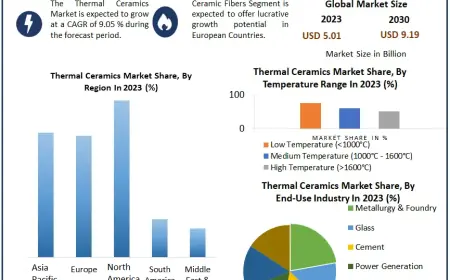CPV Solar Market 2023 Business Advancements and Top-Vendor Landscape to 2032
The Global CPV Solar Market was estimated at USD 5,321.7 Million in 2022 and is projected to reach USD 16,206.5 Million by 2032, experiencing compound annual growth at 12.1% between 2023-2032.

Market Overview
The CPV Solar Market is poised for growth, driven by ongoing advancements in technology, increasing awareness of the benefits of CPV systems, and supportive government policies. With a focus on overcoming challenges related to costs and operational complexities, the CPV market is likely to play a crucial role in the global transition to clean and sustainable energy in the years to come.
The Global CPV Solar Market was estimated at USD 5,321.7 Million in 2022 and is projected to reach USD 16,206.5 Million by 2032, experiencing compound annual growth at 12.1% between 2023-2032.
Optimized CPV Solar Market Dynamics:
Drivers :
To Optimize Land Use: Optimized CPV solar systems take up less land compared to traditional solar panels, making them ideal for areas with limited available space or where maximizing land utilization is crucial.
High Energy Efficiency and Cost-Effectiveness: Concentrated Photovoltaic technology offers increased energy efficiency compared to traditional photovoltaic systems, making it an attractive solution for producing electricity at lower cost per kilowatt-hour.
Improved Technological Performance and Reliability: Recent technological advancements are fueling greater CPV efficiency, greater reliability, and enhanced performance - further expanding its appeal among both consumers and investors alike.
Environmental Sustainability and Clean Energy Goals: Governments and organizations worldwide are setting ambitious clean energy goals, pushing for the adoption of renewable sources such as CPV to lower carbon footprints and combat climate change.
Favorable Government Policies and Incentives: Government policies, subsidies, tax incentives and grants support the installation of photovoltaic (PV) systems by decreasing the initial investment cost for consumers and encouraging adoption.
Get a complimentary PDF sample of our comprehensive report here : https://market.us/report/cpv-solar-market/request-sample/
Restraints:
Capital Intensity: CPV systems tend to be more capital intensive when installed compared to traditional photovoltaic (PV) systems, due to high initial costs associated with tracking mechanisms and high efficiency solar cells that act as barriers of entry for potential investors and buyers.
Technological Complexity and Reliability: CPV technology's complex nature includes precision optics, tracking systems and sophisticated materials that pose unique design, installation and maintenance challenges for systems using this technology. Furthermore, increased technical failure rates increase concerns over system uptime reliability.
Geographical Limitations: Concentrating Photovoltaics (CPV) systems require high Direct Normal Irradiance (DNI), making deployment in regions with lower DNI limited and making this technology ineligible or ineffective for large portions of global solar market.
Land and Space Requirements: Due to their tracking mechanisms and concentrated nature, CPV systems require more land and space than their traditional counterparts; This can pose a considerable challenge in densely populated areas with limited and costly land availability.
Environmental Impact and Sustainability Issues: When manufacturing and installing CPV systems, certain materials used can have detrimental environmental consequences if managed improperly. Concerns regarding their sustainability impact and environmental footprint can significantly alter public perception and policy decisions, ultimately hindering market expansion.
Opportunities:
High Efficiency and Energy Yield: cit Concentrated Photovoltaic technology offers higher efficiency and energy yield than traditional photovoltaic systems, opening up doors for further research and development leading to increased output with reduced costs associated with solar electricity production.
Reducing Levelized Cost of Electricity (LCOE): Recent developments in CPV technology such as optics, tracking systems and manufacturing processes can significantly lower LCOE of CPV systems. Lowering overall production costs makes CPV more cost-competitive with solar energy in terms of electricity production costs.
Hybrid Solar Projects: Integrating CPV systems with other renewable energy sources like storage, wind or traditional PV can create hybrid solar projects. Such integrated systems offer reliable power generation that ensures stable energy supply - offering increased reliability and versatility in energy delivery.
Emerging Markets and Rural Electrification: Concentrated Photovoltaic (CPV) systems can be particularly suitable for emerging markets and rural electrification projects with high solar radiation levels. There may be opportunities to install CPV installations here to alleviate energy poverty while providing clean and sustainable electricity, ultimately aiding economic development while improving quality of life.
Modular and Scalability: CPV systems offer flexible design capabilities with their modularity and scalability, adaptable to suit various project sizes and requirements. There is great opportunity in developing standardised yet easily scalable CPV solutions which facilitate rapid deployment into residential, commercial, or utility-scale settings with rapid deployment times and integration rates.
Cost and Investment Challenges:
Cost and Investment Challenges:CPV technology often involves complex and expensive components like high-efficiency multi-junction solar cells, specialized optics, and sophisticated tracking systems. These factors contribute to higher upfront costs compared to traditional solar photovoltaic systems, making it challenging to attract investors and compete with other solar technologies.
Efficiency and Performance Variability: Concentrated Photovoltaic (CPV) systems rely heavily on direct sunlight and precise tracking mechanisms to achieve maximum efficiency, so any fluctuations due to weather or inaccurate tracking mechanisms could greatly diminish system performance and overall efficiency - creating an ongoing challenge in terms of maintaining high efficiency levels despite changing environmental conditions.
Technological Complexity: Concentrated Photovoltaic systems require precise alignment and tracking mechanisms in order to direct sunlight onto their solar cells accurately, creating technical challenges during installation, operation, and maintenance. Their complex nature poses further difficulties.
Geographic Restrictions: Concentrated Photovoltaic Systems are most effective when placed in environments with plenty of direct sunlight, such as deserts or sunny climates, making their use limited in areas with lesser direct sun or greater cloud cover, thus decreasing their market potential and impact.
Material Availability and Environmental Considerations: Certain high-efficiency solar cell materials used in CPV applications, such as certain semiconductor compounds, may face supply chain challenges due to limited availability or geopolitical concerns. In addition, concerns over environmental impacts of certain materials used may emerge, necessitating efforts towards sustainable sourcing and recycling efforts.
Key Market Segments
Based on Type
- LCPV & MCPV
- HCPV
Based on Application
- Utility
- Commercial
Market Key Players
- SunPower Corp
- 5N Plus, Inc
- Almeco Group
- Sumitomo Electric Industries
- Saint-Augustin Canada Electric Inc.
- Zytech Group
- Arzon Solar
- BSQ Solar
- Green Rhino Energy
- Electron test equipment limited.
- Radical Sun Systems Inc.
- Solergy
- Other Key Players
Browse More Report:
Contact us
Global Business Development Team: Market.us
Market.us (Powered By Prudor Pvt. Ltd.)
Send Email: inquiry@market.us
Address: 420 Lexington Avenue, Suite 300 New York City, NY 10170, United States
Tel: +1 718 618 4351, +91 78878 22626
What's Your Reaction?
 Like
0
Like
0
 Dislike
0
Dislike
0
 Love
0
Love
0
 Funny
0
Funny
0
 Angry
0
Angry
0
 Sad
0
Sad
0
 Wow
0
Wow
0














































